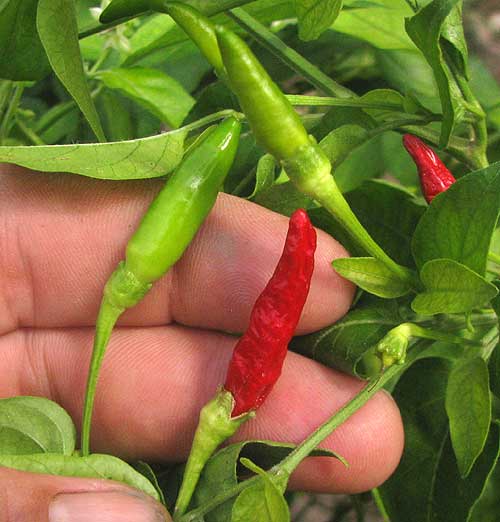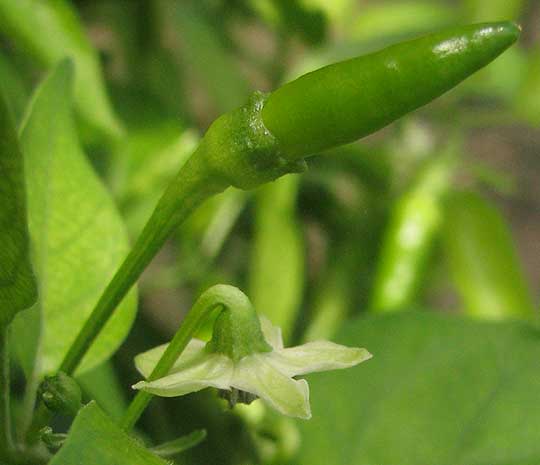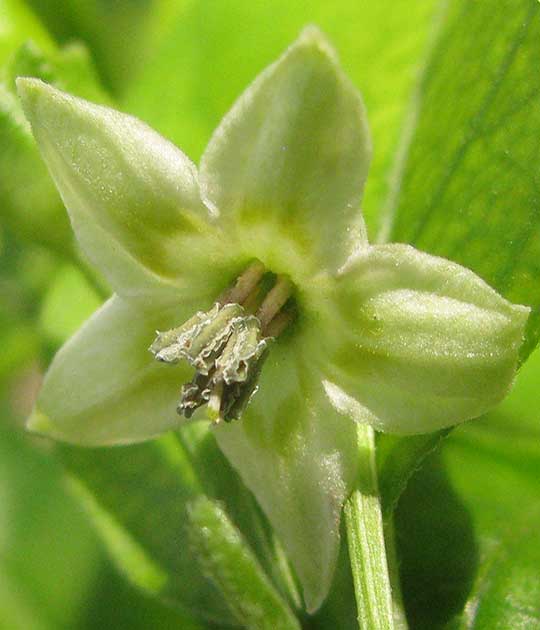Excerpts from Jim Conrad's
Naturalist Newsletter
from the November 10, 2013 Newsletter issued from the Frio Canyon Nature Education Center in the valley of the Dry Frio River in northern Uvalde County, southwestern Texas, on the southern border of the Edwards Plateau; elevation ~1750m (~5750 ft); N29.62°, W99.86°; USA
THAI CHILI
Last year a neighbor returned from Thailand with a chili pepper in his pocket, which he'd bought at a little market there. He saved the seeds and now on Juniper House's deck a potted, knee-high pepper plant from one of those seeds is as lush and pretty as it can be, and loaded with flowers and peppers. You can see a small part of it below:

A flower with its typical crooked neck, next to an immature chili, is shown below:

A flower close-up showing pale anthers with white fringes, possibly caused by bees fraying the anther edges as they collected pollen, is shown below:

Chili peppers are members of the genus Capsicum of the Nightshade or Tomato Family, the Solanaceae, and all Capsicums are native to the Americas. Therefore, this "Thai Chili" is a descendent of American ancestors. That doesn't mean, however, that Thai Chili peppers are not uniquely Asian. Presumably, 500 years ago Spanish galleons carried American chili peppers from the Americas across the Pacific to Asia, and 500 years is plenty of time in which plant breeders can come up with a whole new cultivar.
Cultivars developed from five Capsicum species are produced throughout the world today, so I wondered whether our Thai Chili might have derived from one of the lesser-known species. Capsicum annuum is the most widely cultivated species. Super-hot Habeneros are Capsicum chinense. Tabasco peppers are Capsicum frutescens.
The Peppermainia.Com website provides an identification key to the different species. There our Thai Chili plant easily keyed out to be the commonly grown CAPSICUM ANNUUM, on the basis of its white, unspotted corollas, its flowers arising one per stem node instead of two or more, and the flowers' filaments not being purple. You can find this key a little down the page at http://www.peppermania.com/chile_facts.html.
Besides our Thai Chili, which sometimes is called Bird's-eye Chili, other cultivars developed from the wild Capsicum annuum ancestor include such popular pepper types as bell peppers, cayenne, paprika, Tabasco, and jalapeños.
It's interesting that from Capsicum annuum cultivars have been developed ranging from sweet bell peppers to hot jalapeños. Clearly a pepper's hotness can be selected for during the plant breeding process. Our Thai Chilies strike me as considerably hotter than jalapeños, but I wasn't sure how they stacked up to habeneros, developed from Capsicum chinense.
A pepper's hotness can be designated by "Scoville scale units," or SHUs, which measure the amount of the chemical called Capsaicin in the pepper. Capsaicin stimulates nerve endings, causing the "hot" sensation.
Pure capsaicin clocks in at about 15,000,000 to 16,000,000 SHUs.
The stuff that police use in pepper spray rates about 5,000,000.
The pepper with the highest rating is the Naga Viper Chili, developed in the United Kingdom by crossing the three hottest peppers known to science. It measures 1,359,000 SHUs.
The famously hot Red Savina Habanero rates 580,000 SHUs.
Thai Chilies typically fall between 50,000 to 100,000 SHUs, so they're not as hot as habeneros. However, they're much hotter than jalapeños.
Jalapeños, who some folks regard as very hot, range between 2,500 and 8000 SHUs, so to real chili eaters they're hardly hot at all.
Bell peppers come in at zero SHUs, having no capsaicin at all.